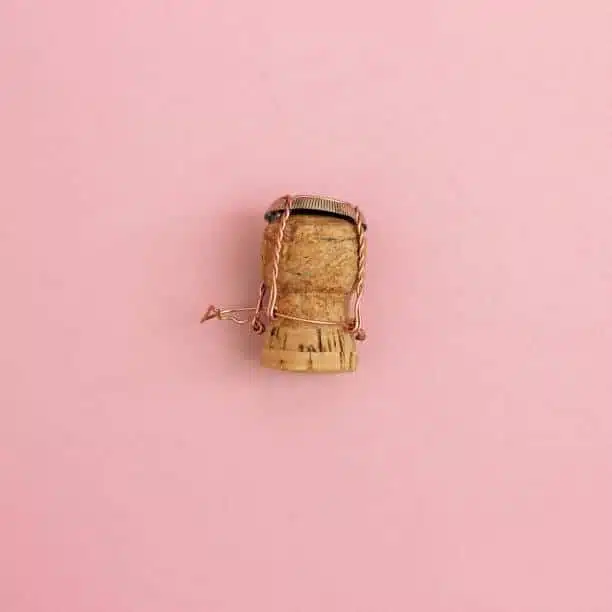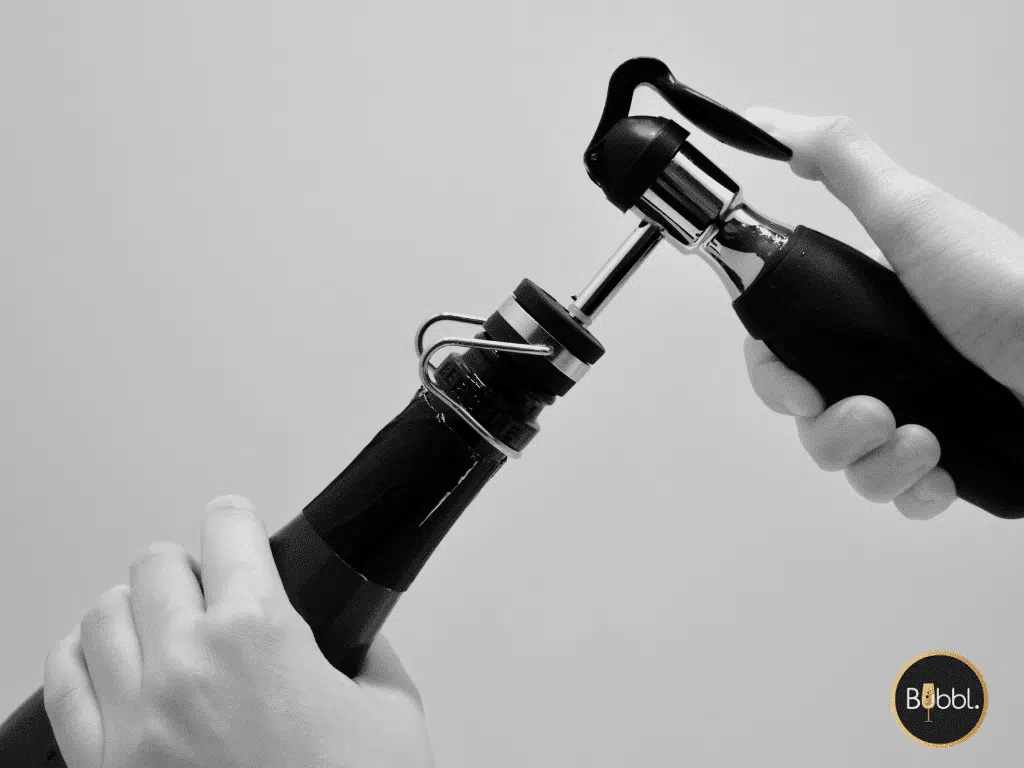What the champagne capsule does for your bottle
Wrapping snugly around a champagne bottle’s neck, the delicate metal capsule (or capsule congé in French) serves multiple purposes. Below it, the twisted wire hood—known as a muselet—keeps the cork firmly in place under pressure. This clever double-seal system forms an airtight cap that protects the precious wine, shows if someone tampered with the bottle, and helps preserve its quality over time.
The small round plate pressed onto the wire cage doesn’t just secure the closure—it’s also a perfect canvas for branding. Through vibrant printing, elegant embossing, or shiny metallic effects, champagne houses turn this tiny surface into collectors’items. For collectors, these distinctive plates become cherished keepsakes from special occasions like weddings, romantic encounters, or memorable tasting events.

How capsule condition signals bottle health
A pristine capsule gives you confidence that a champagnebottle has been stored correctly. Telltale signs like stains, tiny holes, or swelling around the bottle neck or foil might mean the wine leaked, got too warm, or wasn’t handled carefully. On the other hand, a snug aluminium or polylaminate capsule that’s properly crimped after disgorgement usually means both the cork and wire are still in great condition.
Today’s manufacturers offer all kinds of caps, from heavy-duty polylaminate ones to more affordable aluminium or plastic options, depending on price and branding needs. Environmentally conscious buyers can find eco-friendly versions made with plant-based materials, while high-quality printing, embossing, or metallic details allow houses to showcase their wine’s uniqueness on the capsule itself. The wire hoods come in different styles too—with or without decorative plates—to fit various cork types, bottle shapes, and internal pressure levels.
Crown cap versus cork during production
First introduced in 1892, the crown cap plays a crucial role in securing champagne bottles during secondary fermentation, remaining in place until disgorgement. This method creates a superior airtight seal compared to traditional cork closures, helping maintain the wine’s vibrant character while simplifying production. Though natural corks allow subtle oxygen exchange that enhances buttery and nutty flavors, they pose contamination risks and inconsistency between bottles.
Some winemakers experiment by bottling identical wine batches under both crown caps and corks to track their distinct aging effects. Generally, fresh and fruity styles, tank-fermented sparkling wines, and varieties requiring minimal oxidation benefit most from cap sealing. During secondary fermentation, the crown cap’s perfect seal maintains stable pressure, prevents contamination, preserves fruitiness, and ensures bottle-to-bottle consistency.
Material tiers and branding opportunities
The standard conical aluminium cap fits snugly over the wire cage, with coating choices like matte black or metallic finishes affecting both durability and perceived luxury. Some innovative plate designs feature peelable layers that reveal hidden messages, QR codes, or special offers – transforming the simple capsule into an interactive marketing tool.
Luxury limited editions, such as commemorative vintage batches or artist-designed capsules, significantly enhance brand prestige and attract serious collector attention. A thoughtful color coordination between the capsule, wire, and closure creates a cohesive branded look that stands out on store shelves and reinforces the design identity.
Placomusophilia: the art of collecting champagne capsules
The niche hobby of collecting champagne capsules, known as placomusophilia, has grown into a global phenomenon with dedicated collectors trading and discussing each distinctive plate type. While age-based rarity and condition are key value factors, some contemporary limited releases can suddenly surge in demand among enthusiastic collectors.
Specialized catalogs assign ratings and reference numbers, creating a standardized system for authenticating and discussing these miniature artworks. Beyond their collectible status, champagne capsules serve as compact historical records, tracing the evolution of branding through decades. Organized collections – whether displayed in shadowboxes, arranged by theme, or sorted chronologically – transform these metal plates into fascinating visual timelines.
Acquisition and market dynamics
Capsules enter circulation through various channels – from specialty swap meets to producer reissues, while exceptionally rare finds like recovered shipwreck bottles pieces command premium pricing. While official catalog numbers help verify authenticity, collectors should remain cautious about inflated scarcity claims in this fluctuating market. When shipping, opt for tracked services for small parcels and signature confirmation for valuable wine collections.
International shipments may face customs delays, and rural courier services often impose additional restrictions. While some limited editions appreciate rapidly, many remain readily available, emphasizing the importance of thorough research before expanding a collection.
Handling, storage and creative reuse
Proper handling techniques – using tweezers or carefully sliding off the cap instead of gripping – help preserve condition. Optimal storage solutions range from acid-free albums to UV-protected frames, with padded options ideal for traveling to sparkling tasting events. Maintaining detailed records including reference numbers, producer information, and acquisition details ensures the long-term value of your capsule compilation.
Craft experts transform champagne capsules into beautiful jewelry like earrings, cufflinks, and pendants using techniques such as doming, resin finishing, and bezel setting. These same caps can be repurposed into creative home decorations – think eye-catching mosaics, practical fridge magnets, durable resin tabletops, or stunning gradient art pieces. When personalized, they make memorable wedding favors, corporate gifts, or anniversary keepsakes, while hand-painted or enameled versions become highly sought-after limited editions among collectors.
Bubbl. system: modern capsule-inspired preservation
Once you pop the cork on that bottle of champagne, exposure to oxygen begins deteriorating the wine’s quality within hours. The innovative Bubbl. system applies capsule-sealing technology to keep your opened sparkling wines – whether Champagne, Cava, or Prosecco – fresh for up to a week. Using a handheld injector with a reusable Smart Cap stopper, it replenishes the bottle with food-grade gas to maintain perfect bubbles and preserve the wine’s character.
How Smart Cap mimics the original capsule seal
The Smart Cap cleverly combines food-grade silicone with stainless steel to create an airtight seal on standard bottles ranging from 0.75 to 1.5 liters. Its intelligent pressure regulator maintains the ideal 3-4 bar found in unopened sparkling wine, while a special degassing valve removes oxygen after each pour. A quick five-second injection is all it takes, with built-in safety features to automatically vent excess pressure and prevent bottle stress.
For best results, store your bottle upright in a cool place below 10°C – this helps keep the gasket snug and the wine fresh. Use an ice bucket or countertop wine chiller during serving to maintain perfect temperature without compromising protection. Maintenance is a breeze – just rinse and dry the caps after use.
Oenological gas blend: dual-action protection
The system uses specialized champagne cartridges containing an 80% CO₂/20% N₂ blend that creates an optimal preservation atmosphere. The CO₂ maintains natural carbonation while nitrogen forms a protective layer against oxidation and aroma loss. This food-grade mixture is completely neutral – it won’t alter the taste of your Champagne, cider, or other sparkling wines.
Independent tests confirm that this method preserves bubbles and bouquet for up to seven days after opening. Each 21ml cartridge protects approximately five standard bottles (25-30 injections) before needing replacement. Simply unscrew the empty cartridge and insert a fresh one when needed. While unopened cartridges last five years, used ones should be recycled (after purging) and open stock used within six months.
Service workflow for wine-by-the-glass
Here’s the simple process: First uncork your bottle, pour the desired amount, then secure the Smart Cap. A quick five-second gas injection preserves your wine, which you should store chilled in an upright position. With just one trigger pull, staff can protect any open champagne or sparkling wine between servings – reducing waste and expanding your by-the-glass offerings. Multiple Smart Caps allow simultaneous preservation of several bottles, while the Bubbl. system integrates seamlessly with temperature control tools for ideal serving conditions.
For nearly empty bottles, extend the gas injection time since more oxygen needs compressing in the larger headspace. While high-pressure cuvées may lose bubbles quicker than lighter styles like Prosecco, maintaining bubble concentration proves most challenging. Typically, oxidation flavors develop much later – often appearing after weeks rather than days.
Why modern preservation extends capsule heritage
Traditional capsules and wire cages (or wirehoods) excellently protect unopened bottles for years. But once that cork is pulled, CO₂ escapes and oxygen invades. The Bubbl. system solves this issue, making champagne and sparkling wine service profitable by dramatically reducing waste. Customers can enjoy premium vintage pours without committing to a full bottle, and the universal cap accommodates sizes from standard 750ml to magnums.
Manufactured in the EU using Linde Gas (the industry standard), this system benefits from a decade of patented technology and professional use. The durable, low-maintenance equipment simply requires careful trigger use, while refillable cartridges and extra caps make scaling up easy for busy establishments.
Whether you’re safeguarding a special vintage at home or serving Champagne in a busy bar, the principles remain the same: create a tight seal, maintain CO₂ pressure, and displace oxygen. From basic wire hood plates to today’s advanced Smart Caps, every innovation honors the timeless art of keeping your sparkling wine fresh, bubbly, and delicious.

